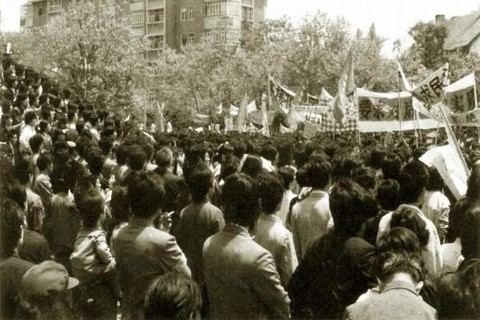<< Read all John Kamm Remembers stories

One month before The Dui Hua Foundation was established in April 1999, American businessman John Kamm traveled to the port city of Qingdao in Shandong Province. He was accompanying a producer of polyvinyl chlorine window frames who was looking for a partner in a joint venture. Kamm was familiar with the city and the work. He had visited Qingdao on several occasions in the late 1980s to negotiate another joint venture, a sodium silicate plant, with then Mayor Yu Zhengsheng—now a member of the Politburo Standing Committee—and became an honorary professor of Qingdao University in April 1990.
When Kamm visited Qingdao in March 1999, the city was reeling from the Asian financial crisis. Like other cities in Shandong, Qingdao saw substantial South Korean investments dry up, as many firms pulled up stakes and departed. Newly established investment zones took on the appearance of ghost towns.
Desperate to attract new investment, leaders of the Qingdao Branch of the China Council for the Promotion of International Trade (CCPIT) asked to meet with John Kamm. Shortly after pleasantries were exchanged, the leaders asked Kamm if he would be willing to serve as honorary chairman of the Qingdao branch.
Kamm was incredulous. He asked the leaders if they knew that he had worked for more than eight years to persuade the Chinese government to free political prisoners, focusing initially on people imprisoned for supporting the spring protests of 1989. The CCPIT leaders said they were aware of Kamm’s work.
After China declared martial law in Beijing on May 20, 1989, and after the killings that followed, protests erupted in hundreds of cities all over the country. Qingdao was the site of especially large protests and accordingly not a few trials for “counterrevolutionary activities.” There was a relationship between the speediness of local trials and the lengthiness of individual sentences. Less time between arrest and trial generally correlated with longer sentences. Shandong held its trials before the end of 1989 and handed down some of the longest sentences in the nation. Many people were convicted of counterrevolutionary incitement and propaganda.
At the meeting, Kamm looked the leaders squarely in the eye. He spoke of the sentencing records in Qingdao and Shandong and declined their invitation. It seemed as if it was the first the leaders had heard of the long sentences being served by those who had engaged in the protests that once paralyzed large parts of Qingdao and Jilin. They asked Kamm if he had a list of names.
Kamm had come prepared. He handed over a list of 10 names and mentioned three individuals: Chen Lantao, a fresh graduate of the Qingdao Oceanography University, sentenced to 18 years in prison in August 1989; Zhang Jie, an unemployed worker, sentenced to 18 years in prison in October 1989; and Niu Shengchang, a farmer, sentenced to 12 years in prison.
The CCPIT officials thanked Kamm for considering their request and promised to look into the list.
Seven weeks later, Niu Shengchang was released nearly two years early. Less than two years later, on December 31, 2000, Chen Lantao was released six and a half years before the end of his sentence. Two weeks after Chen’s release, Zhang Jie was released six and a half years early.
Kamm, by then executive director of Dui Hua, received the news of Chen Lantao’s release while visiting Beijing No.1 Prison in early 2001. There to accompany the foreign visitor, an official of China’s Ministry of Justice stepped aside to take a call. When the official returned, she told Kamm the “good news.” Chen Lantao, then serving one of the longest sentences for counterrevolutionary incitement and propaganda committed during the 1989 protests, had been released.
Listen to the Encounters with China podcast.
Subscribe to receive notifications about new episodes.
Read all John Kamm Remembers stories.
